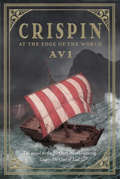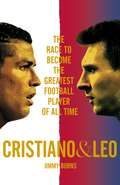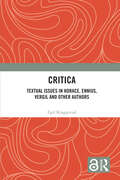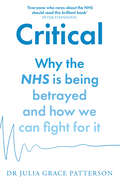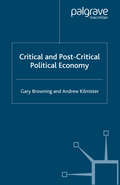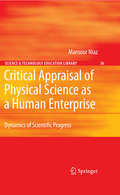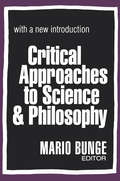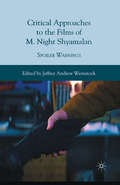- Table View
- List View
Crisis? What crisis?: The Callaghan government and the British ‘winter of discontent’
by John ShepherdOver thirty years later, the ‘winter of discontent’ of 1978–79 still resonates in British politics. On 22 January 1979, 1.5 million workers were on strike. Industrial unrest swept Britain in an Arctic winter. Militant shop stewards blocked medical supplies to hospitals; mountains of rubbish remained uncollected; striking road hauliers threatened to bring the country to a standstill; even the dead were left unburied. Within weeks, the beleaguered Callaghan Labour government fell from power. In the 1979 general election, Margaret Thatcher became Prime Minister, beginning eighteen years of unbroken Conservative rule. Based on a wide range of newly available historical sources and key interviews, this full-length account breaks new ground, analysing the origins, character and impact of a turbulent period of industrial unrest. This important study will appeal to all those interested in contemporary history and British politics.
Crisis? What crisis?: The Callaghan government and the British ‘winter of discontent’
by John ShepherdOver thirty years later, the ‘winter of discontent’ of 1978–79 still resonates in British politics. On 22 January 1979, 1.5 million workers were on strike. Industrial unrest swept Britain in an Arctic winter. Militant shop stewards blocked medical supplies to hospitals; mountains of rubbish remained uncollected; striking road hauliers threatened to bring the country to a standstill; even the dead were left unburied. Within weeks, the beleaguered Callaghan Labour government fell from power. In the 1979 general election, Margaret Thatcher became Prime Minister, beginning eighteen years of unbroken Conservative rule. Based on a wide range of newly available historical sources and key interviews, this full-length account breaks new ground, analysing the origins, character and impact of a turbulent period of industrial unrest. This important study will appeal to all those interested in contemporary history and British politics.
Crispin: At the Edge of the World (Crispin)
by AviIn this riveting sequel to the Newbery-Award winning Crispin: The Cross of Lead--the second book in a planned trilogy--Avi explores themes of war, religion, and family as he continues the adventures of Crispin and Bear.The more I came to know of the world, the more I knew I knew it not.He was a nameless orphan, marked for death by his masters for an unknown crime. Discovering his name- Crispin-only intensified the mystery. Then Crispin met Bear, who helped him learn the secret of his full identity. And in Bear-the enormous, red-bearded juggler, sometime spy, and everyday philosopher-Crispin also found a new father and a new world.Now Crispin and Bear have set off to live their lives as free men. But they don't get far before their past catches up with them: Bear is being pursued by members of the secret brotherhood who believe he is an informer. When Bear is badly wounded, it is up to Crispin to make decisions about their future-where to go, whom to trust. Along the way they become entangled with an extraordinary range of people, each of whom affects Crispin and Bear's journey in unexpected ways. To find freedom and safety, they may have to travel to the edge of the world-even if it means confronting death itself.
Cristiano and Leo: The Race to Become the Greatest Football Player of All Time
by Jimmy BurnsA Financial Times Sports book of the Year 2018 pickWho's better: Ronaldo or Messi? Ask any football fan and they'll have an opinion. For the best part of the last decade football has seen a personal rivalry unlike any seen before. Cristiano and Leo. This is their definitive story, from children kicking a ball halfway around the world from each other to their era-defining battle to be number one. One the preening adonis, a precision physical machine who blows teams away with his pace and power. The other a shuffling genius, able to do things with a football that seem other-worldly. Their differences seem to tap into something fundamental about football and indeed life.Between them they have scored over a thousand goals, won the Ballon d'Or nine times and redefined modern football. For the past eight seasons they have shared the accolade of best footballer in the world and arguments rage over which one deserves the title of greatest player of all time. Cristiano and Leo by Spanish and South American football expert and journalist Jimmy Burns is the essential book to understand the defining players of a generation.'Burns is incapable of writing a boring sentence.' - Irish Times
The Criterion for Distinguishing Legal Opinions from Judicial Rulings and the Administrative Acts of Judges and Rulers (World Thought in Translation)
by Shihab al-Din al-Qarafi al-MalikiThe first and much-needed English translation of a thirteenth-century text that shaped the development of Islamic law in the late middle ages. Scholars of Islamic law can find few English language translations of foundational Islamic legal texts, particularly from the understudied Mamluk era. In this edition of the Tamyiz, Mohammad Fadel addresses this gap, finally making the great Muslim jurist Shihab al-Din al-Qarafi’s seminal work available to a wider audience. Al-Qarafi’s examination of the distinctions among judicial rulings, which were final and unassailable, legal opinions, which were advisory and not binding, and administrative actions, which were binding but amenable to subsequent revision, remained standard for centuries and are still actively debated today.
Critica: Textual Issues in Horace, Ennius, Vergil and Other Authors
by Egil KraggerudGathering together over 60 new and revised discussions of textual issues, this volume represents notorious problems in well-known texts from the classical era by authors including Horace, Ennius, and Vergil.A follow-up to Vegiliana: Critical Studies on the Texts of Publius Vergilius Maro (2017), the volume includes major contributions to the discussion of Horace’s Carmen IV 8 and IV 12, along with studies on Catullus Carmen 67 and Hadrian’s Animula vagula, as well as a new contribution on Livy’s text at IV 20 in connection with Cossus’s spolia opima, and on Vergil’s Aeneid 3. 147–152 and 11. 151–153. On Ennius, the author presents several new ideas on Ann. 42 Sk. and 220–22l, and in editing Horace, he suggests new principles for the critical apparatus and tries to find a balance by weighing both sides in several studies, comparing a conservative and a radical approach.Critica will be an important resource for students and scholars of Latin language and literature.The Open Access version of this book, available at http://www.taylorfrancis.com, has been made available under a Creative Commons Attribution-Non Commercial-No Derivatives (CC-BY-NC-ND) 4.0 license.
Critica: Textual Issues in Horace, Ennius, Vergil and Other Authors
by Egil KraggerudGathering together over 60 new and revised discussions of textual issues, this volume represents notorious problems in well-known texts from the classical era by authors including Horace, Ennius, and Vergil.A follow-up to Vegiliana: Critical Studies on the Texts of Publius Vergilius Maro (2017), the volume includes major contributions to the discussion of Horace’s Carmen IV 8 and IV 12, along with studies on Catullus Carmen 67 and Hadrian’s Animula vagula, as well as a new contribution on Livy’s text at IV 20 in connection with Cossus’s spolia opima, and on Vergil’s Aeneid 3. 147–152 and 11. 151–153. On Ennius, the author presents several new ideas on Ann. 42 Sk. and 220–22l, and in editing Horace, he suggests new principles for the critical apparatus and tries to find a balance by weighing both sides in several studies, comparing a conservative and a radical approach.Critica will be an important resource for students and scholars of Latin language and literature.The Open Access version of this book, available at http://www.taylorfrancis.com, has been made available under a Creative Commons Attribution-Non Commercial-No Derivatives (CC-BY-NC-ND) 4.0 license.
Critical: Why The Nhs Is Being Betrayed And How We Can Fight For It
by Dr Julia PattersonThe true, eye-opening account of how the NHS has been failed and what we can do to save it.
Critical Acting Pedagogy: Intersectional Approaches (ISSN)
by Lisa Peck Evi StamatiouCritical Acting Pedagogy: Intersectional Approaches invites readers to think about pedagogy in actor training as a research field in its own right: to sit with the complex challenges, risks, and rewards of the acting studio; to recognise the shared vulnerability, courage, and love that defines our field and underpins our practices. This collection of chapters, from a diverse group of acting teachers at different points in their careers, working in conservatoires and universities, illuminates current developments in decolonising studios to foreground multiple and intersecting identities in the pedagogic exchange. In acknowledging how their positionality affects their practices and materials, 20 acting teachers from the United Kingdom, the United States, Europe, and Oceania offer practical tools for the social justice acting classroom, with rich insights for developing critical acting pedagogies. Authors test and develop research approaches, drawn from social sciences, to tackle dominant ideologies in organisation, curriculum, and methodologies of actor training.This collection frames current efforts to promote equality, diversity, and inclusivity in the studio. It contributes to the collective movement to improve current educational practice in acting, prioritising well-being, and centering the student experience.
Critical Acting Pedagogy: Intersectional Approaches (ISSN)
by Lisa Peck Evi StamatiouCritical Acting Pedagogy: Intersectional Approaches invites readers to think about pedagogy in actor training as a research field in its own right: to sit with the complex challenges, risks, and rewards of the acting studio; to recognise the shared vulnerability, courage, and love that defines our field and underpins our practices. This collection of chapters, from a diverse group of acting teachers at different points in their careers, working in conservatoires and universities, illuminates current developments in decolonising studios to foreground multiple and intersecting identities in the pedagogic exchange. In acknowledging how their positionality affects their practices and materials, 20 acting teachers from the United Kingdom, the United States, Europe, and Oceania offer practical tools for the social justice acting classroom, with rich insights for developing critical acting pedagogies. Authors test and develop research approaches, drawn from social sciences, to tackle dominant ideologies in organisation, curriculum, and methodologies of actor training.This collection frames current efforts to promote equality, diversity, and inclusivity in the studio. It contributes to the collective movement to improve current educational practice in acting, prioritising well-being, and centering the student experience.
Critical Ancient World Studies: The Case for Forgetting Classics
by Mathura Umachandran Marchella WardThis volume explores and elucidates critical ancient world studies (CAWS), a new model for the study of the ancient world operating critically, setting itself against a long history of a discipline formulated to naturalise a hierarchical, white supremacist origin story for an imagined modern West. CAWS is a methodology for the study of antiquity that shifts away from the assumptions and approaches of the discipline known as classical studies and/or classics. Although it seeks to reckon with the discipline’s colonial history, it is not simply the application of decolonial theory or the search to uncover subaltern narratives in a subject that has special relevance to the privileged and powerful. Rather, it dismantles the structures of knowledge that have led to this privileging, and questions the categories, ideas, themes, narratives, and epistemological structures that have been deemed objective and essential within the inherited discipline of classics. The contributions in this book, by an international group of researchers, offer a variety of situated, embodied perspectives on the question of how to imagine a more critical discipline, rather than a unified single view. The volume is divided into four parts – “Critical Epistemologies”, “Critical Philologies”, “Critical Time and Critical Space”, and “Critical Approaches” – and uses these as spaces to propose disciplinary transformation. Critical Ancient World Studies: The Case for Forgetting Classics is a must-read for scholars and practitioners teaching in the field of classical studies, and the breadth of examples also makes it an invaluable resource for anyone working on the ancient world, or on confronting Eurocentrism, within other disciplines.
Critical Ancient World Studies: The Case for Forgetting Classics
This volume explores and elucidates critical ancient world studies (CAWS), a new model for the study of the ancient world operating critically, setting itself against a long history of a discipline formulated to naturalise a hierarchical, white supremacist origin story for an imagined modern West. CAWS is a methodology for the study of antiquity that shifts away from the assumptions and approaches of the discipline known as classical studies and/or classics. Although it seeks to reckon with the discipline’s colonial history, it is not simply the application of decolonial theory or the search to uncover subaltern narratives in a subject that has special relevance to the privileged and powerful. Rather, it dismantles the structures of knowledge that have led to this privileging, and questions the categories, ideas, themes, narratives, and epistemological structures that have been deemed objective and essential within the inherited discipline of classics. The contributions in this book, by an international group of researchers, offer a variety of situated, embodied perspectives on the question of how to imagine a more critical discipline, rather than a unified single view. The volume is divided into four parts – “Critical Epistemologies”, “Critical Philologies”, “Critical Time and Critical Space”, and “Critical Approaches” – and uses these as spaces to propose disciplinary transformation. Critical Ancient World Studies: The Case for Forgetting Classics is a must-read for scholars and practitioners teaching in the field of classical studies, and the breadth of examples also makes it an invaluable resource for anyone working on the ancient world, or on confronting Eurocentrism, within other disciplines.
Critical and Post-Critical Political Economy
by G. Browning A. KilmisterThis book is original in focusing on critical political economy, identifying its character and reviewing its continuing legacy. In doing so it throws new light on Hegel and Marx and a range of subsequent theorist. It also develops a perspective on topics such as postmodernism, globalization, identity politics and the cultural turn.
Critical Appraisal of Physical Science as a Human Enterprise: Dynamics of Scientific Progress (Contemporary Trends and Issues in Science Education #36)
by Mansoor NiazIt is generally believed that doing science means accumulating empirical data with no or little reference to the interpretation of the data based on the scientist’s th- retical framework or presuppositions. Holton (1969a) has deplored the widely accepted myth (experimenticism) according to which progress in science is presented as the inexorable result of the pursuit of logically sound conclusions from un- biguous experimental data. Surprisingly, some of the leading scientists themselves (Millikan is a good example) have contributed to perpetuate the myth with respect to modern science being essentially empirical, that is carefully tested experim- tal facts (free of a priori conceptions), leading to inductive generalizations. Based on the existing knowledge in a field of research a scientist formulates the guiding assumptions (Laudan et al. , 1988), presuppositions (Holton, 1978, 1998) and “hard core” (Lakatos, 1970) of the research program that constitutes the imperative of presuppositions, which is not abandoned in the face of anomalous data. Laudan and his group consider the following paraphrase of Kant by Lakatos as an important guideline: philosophy of science without history of science is empty. Starting in the 1960s, this “historical school” has attempted to redraw and replace the positivist or logical empiricist image of science that dominated for the first half of the twentieth century. Among other aspects, one that looms large in these studies is that of “guiding assumptions” and has considerable implications for the main thesis of this monograph (Chapter 2).
Critical Approaches to Genocide: History, Politics and Aesthetics of 1915 (Mass Violence in Modern History)
by Hülya Adak Fatma Müge Göçek Ronald Grigor SunyThe study of genocide has been appropriate in emphasizing the centrality of the Holocaust; yet, other preceding episodes of mass violence are of great significance. Taking a transnational and transhistorical approach, this volume redresses and replaces the silencing of the Armenian Genocide. Scholarship relating to the history of denial, comparative approaches in the deportations and killings of Greeks and Armenians during the First World War, and women’s histories during the genocide and post-genocide proliferated during the centennial of the Armenian Genocide in 2015. Collectively, however, these studies have not been enough to offer a comprehensive account of the historical record, documentation, and interpretation of events during 1915-1916. This study seeks to bridge the gap, by unsettling nationalist narratives and addressing areas such as aesthetics, gender, and sexuality. By bringing forward various dimensions of the human experience, including the political, socioeconomic, cultural, social, gendered, and legal contexts within which such silencing occurred, the essays address the methodological silences and processes of selectivity and exclusion in scholarship on the Armenian Genocide. The interdisciplinary approach makes Critical Approaches to Genocide a useful resource for all students and scholars interested in the Armenian Genocide and memory studies.
Critical Approaches to Genocide: History, Politics and Aesthetics of 1915 (Mass Violence in Modern History)
by Hülya Adak Fatma Müge Göçek Ronald Grigor SunyThe study of genocide has been appropriate in emphasizing the centrality of the Holocaust; yet, other preceding episodes of mass violence are of great significance. Taking a transnational and transhistorical approach, this volume redresses and replaces the silencing of the Armenian Genocide. Scholarship relating to the history of denial, comparative approaches in the deportations and killings of Greeks and Armenians during the First World War, and women’s histories during the genocide and post-genocide proliferated during the centennial of the Armenian Genocide in 2015. Collectively, however, these studies have not been enough to offer a comprehensive account of the historical record, documentation, and interpretation of events during 1915-1916. This study seeks to bridge the gap, by unsettling nationalist narratives and addressing areas such as aesthetics, gender, and sexuality. By bringing forward various dimensions of the human experience, including the political, socioeconomic, cultural, social, gendered, and legal contexts within which such silencing occurred, the essays address the methodological silences and processes of selectivity and exclusion in scholarship on the Armenian Genocide. The interdisciplinary approach makes Critical Approaches to Genocide a useful resource for all students and scholars interested in the Armenian Genocide and memory studies.
Critical Approaches to Heritage for Development (Rethinking Development)
by Charlotte Cross John D. GiblinThis book investigates the relationship between heritage and development from the global visions articulated by UNESCO and the Sustainable Development Goals (SDGs) to local activism, livelihood innovations and political strategies employed in diverse countries of the Global South. In recent years, as culturally informed approaches to international development have become increasingly important, engaging with heritage has been seen as a way to draw on practices and meanings from the past to help build future development. This book gathers researchers and practitioners from across disciplines to address important themes such as health, the environment, sustainability, peace, security, tourism and economic growth. In doing so, the book asks us to consider whose past and whose future is ultimately at stake in efforts to use heritage for development. Key topics explored include histories and legacies of colonialism and calls for decolonisation, and related questions of expertise, ownership and agency. Students, practitioners and researchers from across the broad areas of history, heritage, education, archaeology, geography and development studies will find this book an invaluable guide to dynamic and contested understandings of heritage and development and the relationship between them.
Critical Approaches to Heritage for Development (Rethinking Development)
by Charlotte Cross John D. GiblinThis book investigates the relationship between heritage and development from the global visions articulated by UNESCO and the Sustainable Development Goals (SDGs) to local activism, livelihood innovations and political strategies employed in diverse countries of the Global South. In recent years, as culturally informed approaches to international development have become increasingly important, engaging with heritage has been seen as a way to draw on practices and meanings from the past to help build future development. This book gathers researchers and practitioners from across disciplines to address important themes such as health, the environment, sustainability, peace, security, tourism and economic growth. In doing so, the book asks us to consider whose past and whose future is ultimately at stake in efforts to use heritage for development. Key topics explored include histories and legacies of colonialism and calls for decolonisation, and related questions of expertise, ownership and agency. Students, practitioners and researchers from across the broad areas of history, heritage, education, archaeology, geography and development studies will find this book an invaluable guide to dynamic and contested understandings of heritage and development and the relationship between them.
Critical Approaches to Science and Philosophy
by Mario BungeThis collection of essays, written on four continents by scientists, philosophers and humanists, was initially presented to Karl R. Popper on his sixtieth birthday as a token of critical admiration and in recognition of his work. But the volume also stands on its own as a remarkable series of statements utilizing Popper's critical vision in the study of philosophy proper, logic, mathematics, science as method and theory, and finally to the study of society and history. What is remarkable is that Popper worked in all of these areas, not in a cursory or discursive way, but with the utmost clarity and rigor.. The core position of this volume and its contributors is that the progress of knowledge is not a linear accumulation of definitive acquisitions but a zigzagging process in which counterexamples and unfavorable evidence ruin generalizations and prompt the invention of more comprehensive and sometimes deeper generalizations, to be criticized in their turn. A critical approach to problems, procedures, and results in every field of inquiry is therefore a necessary condition for the continuance of progress.The title of this volume then is, in a sense, an homage to Popper's critical rationalism and critical empiricism. The essays are a tribute to his unceasing and uncompromising quest, not for final certainty, but for closer truth and increased clarity. Among the contributors are outstanding figures in philosophy and the exact sciences in their own right, including Herbert Feigl, R. M. Hare, J.O. Wisdom, Nicholas Rescher, David Bohm, Paul K. Feyerabend, F. A. Hayek, and Adolf Grunbaum. Social science contributions include Hans Albert on social science and moral philosophy, W. B. Gallie, on the critical philosophy of history, Pieter Geyl on The Open Society and its Enemies, and George H. Nadel on the philosophy of History.
Critical Approaches to Science and Philosophy
by Mario BungeThis collection of essays, written on four continents by scientists, philosophers and humanists, was initially presented to Karl R. Popper on his sixtieth birthday as a token of critical admiration and in recognition of his work. But the volume also stands on its own as a remarkable series of statements utilizing Popper's critical vision in the study of philosophy proper, logic, mathematics, science as method and theory, and finally to the study of society and history. What is remarkable is that Popper worked in all of these areas, not in a cursory or discursive way, but with the utmost clarity and rigor.. The core position of this volume and its contributors is that the progress of knowledge is not a linear accumulation of definitive acquisitions but a zigzagging process in which counterexamples and unfavorable evidence ruin generalizations and prompt the invention of more comprehensive and sometimes deeper generalizations, to be criticized in their turn. A critical approach to problems, procedures, and results in every field of inquiry is therefore a necessary condition for the continuance of progress.The title of this volume then is, in a sense, an homage to Popper's critical rationalism and critical empiricism. The essays are a tribute to his unceasing and uncompromising quest, not for final certainty, but for closer truth and increased clarity. Among the contributors are outstanding figures in philosophy and the exact sciences in their own right, including Herbert Feigl, R. M. Hare, J.O. Wisdom, Nicholas Rescher, David Bohm, Paul K. Feyerabend, F. A. Hayek, and Adolf Grunbaum. Social science contributions include Hans Albert on social science and moral philosophy, W. B. Gallie, on the critical philosophy of history, Pieter Geyl on The Open Society and its Enemies, and George H. Nadel on the philosophy of History.
Critical Approaches to the Films of M. Night Shyamalan: Spoiler Warnings
by Jeffrey Andrew WeinstockCritical Approaches to the Films of M. Night Shyamalan represents the first serious academic engagement with auteur director M. Night Shyamalan and his work. The essays, including contributions from established film scholars David Sterritt, Murray Pomerance, Emmanuel Burdeau, R. Barton Palmer, Matt Hills, and Katherine Fowkes, explore the Hollywood blockbusters from The Sixth Sense to The Happening in terms of their themes, aesthetics, and marketing. Taken together, the collection recognizes and explores Shyamalan s "star status" and offers the concerted analysis that this cultural phenomenon requires.
Critical Approaches to the History of Western Herbal Medicine: From Classical Antiquity to the Early Modern Period
by Susan Francia Anne StobartWhy has the history of Western herbal medicine received such little research coverage in any systematic and authoritative way, even though it has figured large in both lay and learned healthcare of the past? What methods and sources are most appropriate for the study of medicinal herbs and herbal practices of the past? This collection provides historians with a coherent guide to a variety of sources in relation to medicinal plants that they have thus far lacked.Critical Approaches to the History of Western Herbal Medicine encourages a serious re-assessment of research in the history of herbal medicine and provides examples of appropriate methodologies and critical examinations of relevant sources. In this innovative collection, historians and researchers from a range of disciplines come together to share material on the identification and use of medicinal plants, the activities of people involved with herbal medicine and the investigation of past herbal therapeutic beliefs and practice. Classical and medieval scholars, social and literary historians, archaeologists and ethnobotanists all contribute to this exploration of the history of Western herbal medicine.
Critical Approaches to the History of Western Herbal Medicine: From Classical Antiquity to the Early Modern Period
by Susan Francia Anne StobartWhy has the history of Western herbal medicine received such little research coverage in any systematic and authoritative way, even though it has figured large in both lay and learned healthcare of the past? What methods and sources are most appropriate for the study of medicinal herbs and herbal practices of the past? This collection provides historians with a coherent guide to a variety of sources in relation to medicinal plants that they have thus far lacked.Critical Approaches to the History of Western Herbal Medicine encourages a serious re-assessment of research in the history of herbal medicine and provides examples of appropriate methodologies and critical examinations of relevant sources. In this innovative collection, historians and researchers from a range of disciplines come together to share material on the identification and use of medicinal plants, the activities of people involved with herbal medicine and the investigation of past herbal therapeutic beliefs and practice. Classical and medieval scholars, social and literary historians, archaeologists and ethnobotanists all contribute to this exploration of the history of Western herbal medicine.
Critical Approaches to TV and Film Set Design
by Geraint D'ArcyThe analysis of scenic design in film and television is often neglected, with visual design elements relegated to part of the mise-en-scène in cinema or simply as "wallpaper" in television. Critical Approaches to TV and Film Set Design positions itself from the audience perspective to explore how we watch TV and film, and how set design enhances and influences the viewing experience. By using semiotics, history and narratology and adding concepts drawn from art, architecture and theatre, Geraint D’Arcy reworks the key concepts of set design. Looking at the impact of production design on how the viewer reads film and television, these updated theories can be applied more flexibly and extensively in academic criticism. D’Arcy creates a new theoretical approach, representing a significant expansion of the field and filling the remaining gaps. This book is ideal for anyone interested in understanding how we can read and interpret design in film and television, and should be the primary point of reference for those studying TV and film set design.


